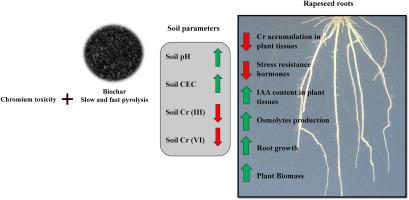Biochar solutions: Slow and fast pyrolysis effects on chromium stress in rapeseed roots
IF 6.1
2区 生物学
Q1 PLANT SCIENCES
引用次数: 0
Abstract
Chromium (Cr) contamination in agricultural soils, largely due to industrial activities, poses a significant threat to plant growth and productivity. This study examines the effects of Cr stress at concentrations of 100 and 200 mg of K2Cr2O7 per kg soil on rapeseed (Brassica napus) roots and evaluates the mitigating potential of biochar. Biochar, produced through both slow and fast pyrolysis and applied at 30 g per kg soil, was investigated for its ability to neutralize Cr toxicity. Our findings indicate that Cr stress significantly decreased the growth and physiological functions of rapeseed roots. However, biochar application improved soil pH, cation exchange capacity, and the uptake of essential nutrients such as nitrogen, phosphorus, potassium, calcium, and magnesium. Additionally, biochar enhanced the production of osmotic regulators like glycine betaine and soluble proteins, as well as indole acetic acid, promoting better root growth and water uptake under Cr stress. Notably, biochar reduced Cr availability and absorption in rapeseed roots, leading to lower levels of stress-related hormones such as abscisic acid, salicylic acid, and jasmonic acid. Among the biochars tested, slow pyrolysis biochar was more effective than fast pyrolysis biochar in mitigating Cr toxicity. These results highlight the potential of slow pyrolysis biochar as a sustainable strategy to alleviate Cr pollution and enhance plant resilience in contaminated soils.

生物炭溶液:慢速和快速热解对油菜根部铬胁迫的影响
农业土壤中的铬(Cr)污染主要是由工业活动造成的,对植物的生长和生产力构成了严重威胁。本研究考察了每公斤土壤中 100 和 200 毫克 K2Cr2O7 浓度的铬胁迫对油菜根系的影响,并评估了生物炭的缓解潜力。生物炭是通过慢速和快速热解产生的,每公斤土壤施用 30 克生物炭,研究了生物炭中和铬毒性的能力。我们的研究结果表明,铬胁迫显著降低了油菜根系的生长和生理功能。然而,施用生物炭改善了土壤的 pH 值、阳离子交换能力以及对氮、磷、钾、钙和镁等必需养分的吸收。此外,生物炭还提高了渗透调节剂(如甘氨酸甜菜碱和可溶性蛋白质)以及吲哚乙酸的产量,促进了根系在铬胁迫下的生长和水分吸收。值得注意的是,生物炭减少了油菜根系对铬的利用和吸收,导致脱落酸、水杨酸和茉莉酸等与胁迫相关的激素水平降低。在测试的生物炭中,慢速热解生物炭在减轻铬毒性方面比快速热解生物炭更有效。这些结果凸显了慢速热解生物炭作为一种可持续战略,在减轻铬污染和提高受污染土壤中植物的抗逆性方面的潜力。
本文章由计算机程序翻译,如有差异,请以英文原文为准。
求助全文
约1分钟内获得全文
求助全文
来源期刊
CiteScore
11.10
自引率
3.10%
发文量
410
审稿时长
33 days
期刊介绍:
Plant Physiology and Biochemistry publishes original theoretical, experimental and technical contributions in the various fields of plant physiology (biochemistry, physiology, structure, genetics, plant-microbe interactions, etc.) at diverse levels of integration (molecular, subcellular, cellular, organ, whole plant, environmental). Opinions expressed in the journal are the sole responsibility of the authors and publication does not imply the editors'' agreement.
Manuscripts describing molecular-genetic and/or gene expression data that are not integrated with biochemical analysis and/or actual measurements of plant physiological processes are not suitable for PPB. Also "Omics" studies (transcriptomics, proteomics, metabolomics, etc.) reporting descriptive analysis without an element of functional validation assays, will not be considered. Similarly, applied agronomic or phytochemical studies that generate no new, fundamental insights in plant physiological and/or biochemical processes are not suitable for publication in PPB.
Plant Physiology and Biochemistry publishes several types of articles: Reviews, Papers and Short Papers. Articles for Reviews are either invited by the editor or proposed by the authors for the editor''s prior agreement. Reviews should not exceed 40 typewritten pages and Short Papers no more than approximately 8 typewritten pages. The fundamental character of Plant Physiology and Biochemistry remains that of a journal for original results.

 求助内容:
求助内容: 应助结果提醒方式:
应助结果提醒方式:


